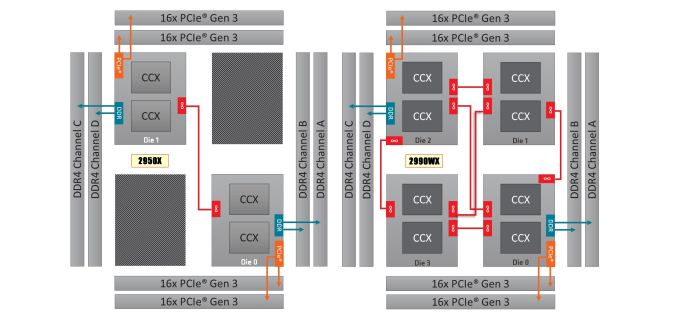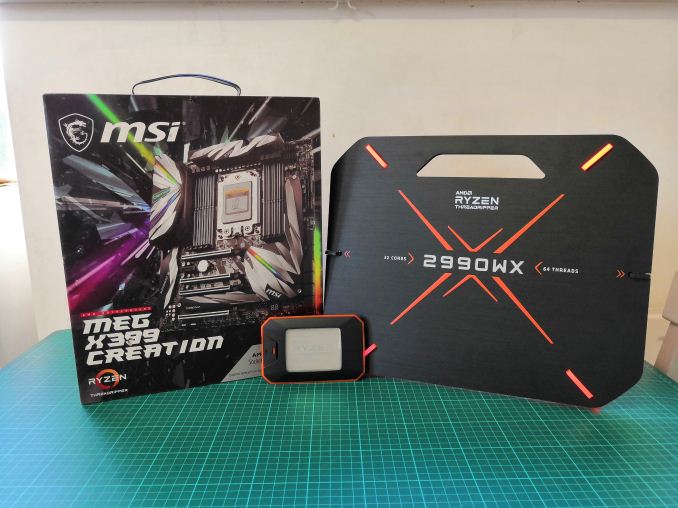The AMD Threadripper 2990WX 32-Core and 2950X 16-Core Review
by Dr. Ian Cutress on August 13, 2018 9:00 AM ESTConclusions: Not All Cores Are Made Equal
Designing a processor is often a finely tuned craft. To get performance, the architect needs to balance compute with throughput and at all times have sufficient data in place to feed the beast. If the beast is left idle, it sits there and consumes power, while not doing any work. Getting the right combination of resources is a complex task, and the reason why top CPU companies hire thousands of engineers to get it to work right. As long as the top of the design is in place, the rest should follow.
Sometimes, more esoteric products fall out of the stack. The new generation of AMD Ryzen Threadripper processors are just that – a little esoteric. The direct replacements for the previous generation units, replacing like for like but with better latency and more frequency, are a known component at this point and we get the expected uplift. It is just this extra enabled silicon in the 2990WX, without direct access to memory, is throwing a spanner in the works.
2950X (left) and 2990WX (right)
When some cores are directly connected to memory, such as the 2950X, all of the cores are considered equal enough that distributing a workload is a fairly easy task. With the new processors, we have the situation on the right, where only some cores are directly attached to memory, and others are not. In order to go from one of these cores to main memory, it requires an extra hop, which adds latency. When all the cores are requesting access, this causes congestion.
In order to take the full advantage of this setup, the workload has to be memory light. In workloads such as particle movement, ray-tracing, scene rendering, and decompression, having all 32-cores shine a light means that we set new records in these benchmarks.
In true Janus style, for other workloads that are historically scale with cores, such as physics, transcoding, and compression, the bi-modal core caused significant performance regression. Ultimately, there seems to be almost no middle ground here – either the workload scales well, or it sits towards the back of our high-end testing pack.
Part of the problem relates to how power is distributed with these big core designs. As shown on page four, the more chiplets that are in play, or the bigger the mesh, the more power gets diverted from the cores to the internal networking, such as the uncore or Infinity Fabric. Comparing the one IF link in the 2950X to the six links in 2990WX, we saw the IF consuming 60-73% of the chip power total at small workloads, and 25-40% at high levels.
In essence, at full load, a chip like the 2990WX is only using 60% of its power budget for CPU frequency. In our EPYC 7601, because of the additional memory links, the cores were only consuming 50% of the power budget at load. Rest assured, once AMD and Intel have finished fighting over cores, the next target on their list will be this interconnect.
But the knock on effect of not using all the power for the cores, as well as having a bi-modal operation of cores, is that some workloads will not scale: or in some cases regress.
The Big Cheese: AMD’s 32-Core Behemoth
There is no doubting that when the AMD Ryzen Threadripper 2990WX gets a change to work its legs, it will do so with gusto. We were able to overclock the system to 4.0 GHz on all cores by simply changing the BIOS settings, although AMD also supports features like Precision Boost Overdrive in Windows to get more out of the chip. That being said, the power consumption when using half of the cores at 4.0 GHz pushes up to 260W, leaving a full loaded CPU nudging 450-500W and spiking at over 600W. Users will need to make sure that their motherboard and power supply are up to the task.
This is the point where I mention if we would recommend AMD’s new launches. The 2950X slots right in to where the 1950X used to be, and at a lower price point, and we are very comfortable with that. However the 2950X already sits as a niche proposition for high performance – the 2990WX takes that ball and runs with it, making it a niche of a niche. To be honest, it doesn’t offer enough cases where performance excels as one would expect – it makes perfect sense for a narrow set of workloads where it toasts the competition. It even outperforms almost all the other processors in our compile test. However there is one processor that did beat it: the 2950X.
For most users, the 2950X is enough. For the select few, the 2990WX will be out of this world.












171 Comments
View All Comments
MrSpadge - Monday, August 13, 2018 - link
I don't think AVX512 is going to matter much anytime soon. However, The 8 memory channels of EPYC could matter a lot for HPC.ElFenix - Monday, August 13, 2018 - link
You guys need a 4k or maybe even 5k workload for transcoding - it's thread limited at 1080p so it becomes IPC and turbo limited. With x265 you can load up multiple 1080p handbrake instances on these high core count processors and they don't break a sweat.ElFenix - Monday, August 13, 2018 - link
That should be *1080p spawns limited numbers of threads*T1beriu - Monday, August 13, 2018 - link
>Europe is famed for its lack of air conditioning everywhereUK is a lot colder generally in the summer compared to the rest of Europe. I wouldn't generalize the lack of AC for the rest of Europe. AC is pretty common in my country.
jospoortvliet - Saturday, August 18, 2018 - link
Missing everywhere here in Germany... though after this insanely hot summer i bet that that will begin to change...powerincarnate - Monday, August 13, 2018 - link
I didn't see a lot of gaming benchmarks, which I guess I understand, since these are more workstation cpus. It would be good to have seen both though to get a better idea of the overall qualities of the cpu as a multipurpose care.It seems from tomshardware benches that 7980xe, especially when overclocked, is best overall. AMD 2990wx obviously winning on the pure multi-threaded workstation stuff as long as it is not memory intensive.
It seems like the 2950x from both of these sites, is really the processor to get from the threadripper lineup.
it seems when gaming is taken to account, the best of both worlds is the 7900x
And for gaming, and when you factor price as well, the 8700k, 8086, and slightly behind, the 2700x are the cards to get.
Overall.... I'm a little disappointed in this release. Was much more impressed with the 2700x. It's likely since we didn't really get a true change in the manufacturing process or design of the chip, that the limitations of the 2990wx will probably be ironed out with Zen2 (this is Zen+ after all).
bill.rookard - Monday, August 13, 2018 - link
Looking at it myself, yeah - these really aren't gaming CPUs by any stretch of the imagination, thus the lack of gaming benchmarks is perfectly understandable to me. As for the results of the benchmark results? I'm thinking the 2950x is the sweet spot. Lower power, lower latency, more power for the cores vs interconnects, and a much higher clockspeed makes it IMHO the better choice unless you have those fringe workloads which requires a bunch-o-cores.shendxx - Monday, August 13, 2018 - link
this guy come from Toms that said 7900x is best for both world, lol, when the graph from toms show clearly even on gaming, 2950x is equal on Minimum FPS with 8700k and only lose 3 to 10 FPS On Average,apoclypse - Monday, August 13, 2018 - link
I don't know. Gaming performance is the least thing I care about with this chip but that seems be all most tech press cares about, especially tech tubers. These chips are not for gaming. If anything these chips should be compared to Intel's Xeon line as it seems that is actually where AMD is aiming these at since they don't have a dedicated SKU for workstation chips like Intel. These are only marketed as HEDT chips because it gives AMD positive press, but if anything the ones who should be paying attention should be OEM high end workstation builders. In that regard Threadripper is more than compelling. It's higher clocked than Intel's Xeon chips, has more cores for less money, and still has all the pro level features that is needed for workstation level work.I think AMD should lean into that a bit more in their marketing but that stuff isn't sexy and it doesn't grab attention like marketing it towards rich and stupid "gamers", and the technorati who eat that stuff up.
This is a workstation chip period, and should be treated, tested and benchmarked as such, imo.
Icehawk - Monday, August 13, 2018 - link
If only the tier 1 vendors would offer TR workstations... I really wanted to purchase a few for work to use as VM hosts but my only real option is Xeon currently. The 32 core monster would likely make for a great VM host for mid-weight usage.